Investigation: Aquatic Therapy Versus Land-Based Therapy for Elderly
VerifiedAdded on 2022/03/10
|11
|2843
|27
Report
AI Summary
This report investigates the comparative effectiveness of aquatic therapy versus land-based therapy for the rehabilitation of the elderly and individuals with disabilities. The study reviews existing literature, including peer-reviewed journals from 2016 to 2020, to assess the benefits of hydrotherapy. The research explores how aquatic therapy utilizes the unique physical properties of water, such as buoyancy and resistance, to aid in improving balance, reducing pain, and enhancing sensory processing skills. The report highlights key findings, such as the positive impact of aquatic therapy on balance disorders, arthritis, and Parkinson's disease, as well as its potential for improving sensory processing and communication skills. The study concludes that aquatic therapy is more efficient than land-based therapy in healing old and disabled cases. The report emphasizes the importance of considering both the physical and psychological factors in rehabilitation and the need for therapists to provide motivation and education to clients. The study finds that water therapy's unique properties, such as buoyancy and pressure, make it effective in reducing the apparent weight of patients and improving their balance and reducing fall risks.
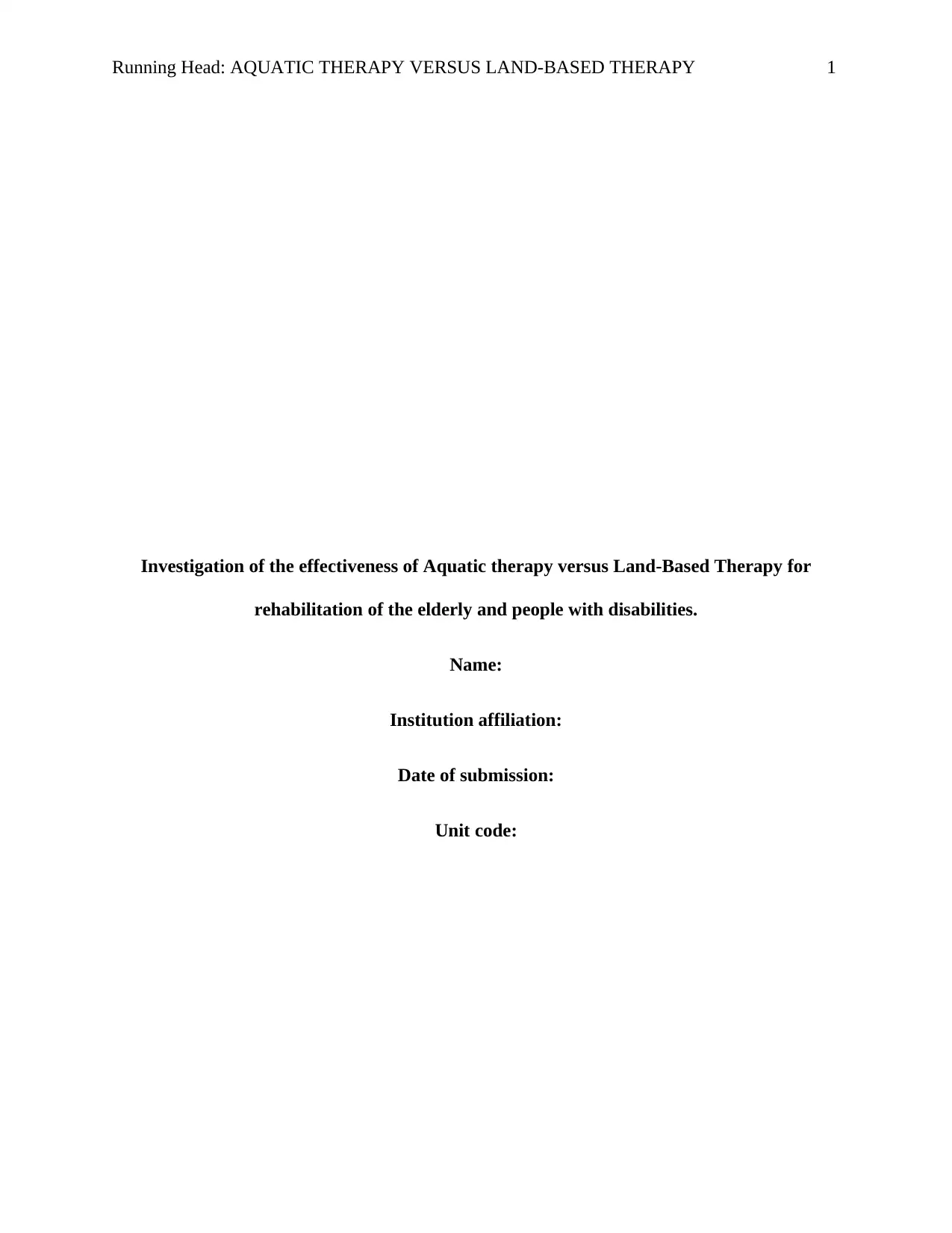
Running Head: AQUATIC THERAPY VERSUS LAND-BASED THERAPY 1
Investigation of the effectiveness of Aquatic therapy versus Land-Based Therapy for
rehabilitation of the elderly and people with disabilities.
Name:
Institution affiliation:
Date of submission:
Unit code:
Investigation of the effectiveness of Aquatic therapy versus Land-Based Therapy for
rehabilitation of the elderly and people with disabilities.
Name:
Institution affiliation:
Date of submission:
Unit code:
Paraphrase This Document
Need a fresh take? Get an instant paraphrase of this document with our AI Paraphraser
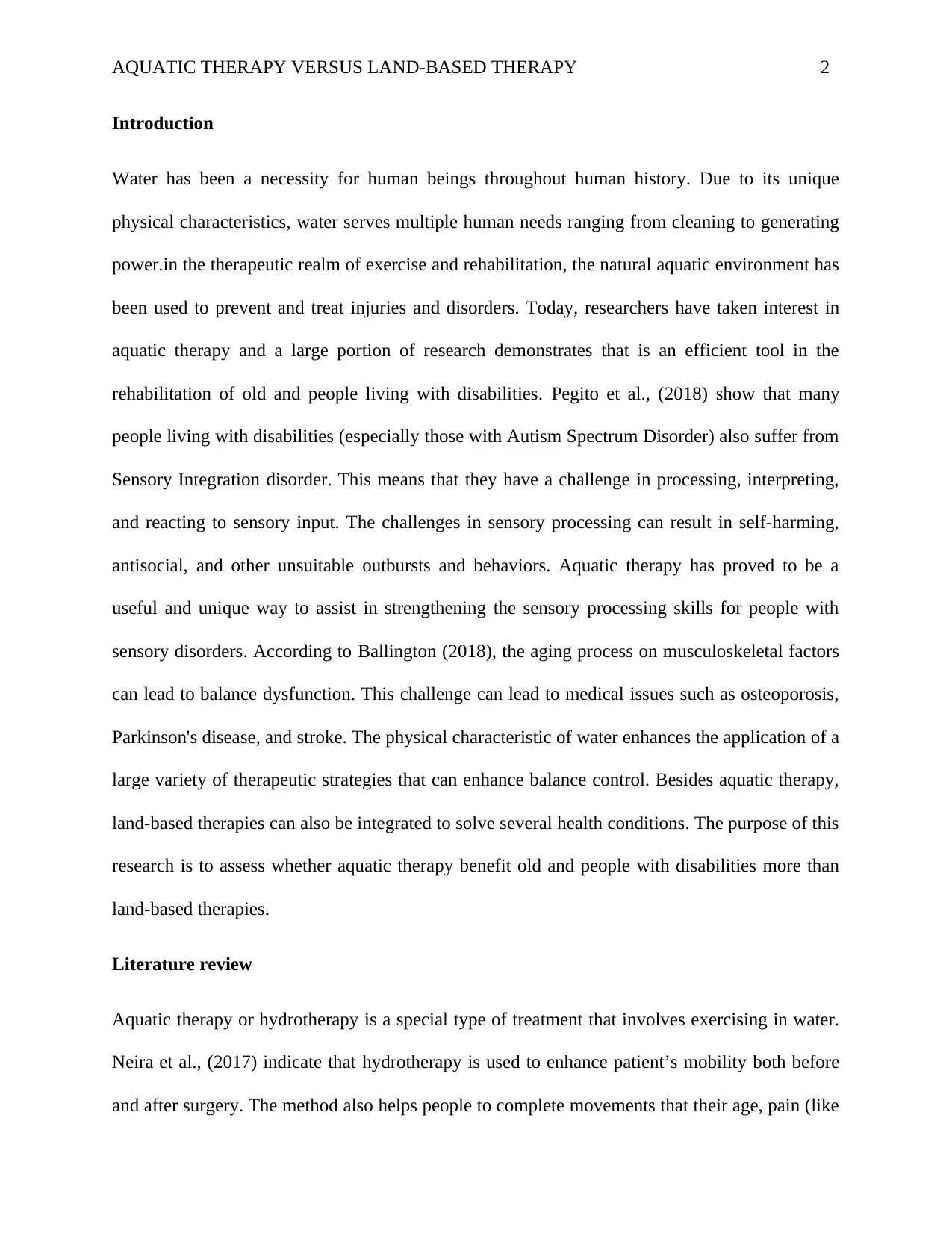
AQUATIC THERAPY VERSUS LAND-BASED THERAPY 2
Introduction
Water has been a necessity for human beings throughout human history. Due to its unique
physical characteristics, water serves multiple human needs ranging from cleaning to generating
power.in the therapeutic realm of exercise and rehabilitation, the natural aquatic environment has
been used to prevent and treat injuries and disorders. Today, researchers have taken interest in
aquatic therapy and a large portion of research demonstrates that is an efficient tool in the
rehabilitation of old and people living with disabilities. Pegito et al., (2018) show that many
people living with disabilities (especially those with Autism Spectrum Disorder) also suffer from
Sensory Integration disorder. This means that they have a challenge in processing, interpreting,
and reacting to sensory input. The challenges in sensory processing can result in self-harming,
antisocial, and other unsuitable outbursts and behaviors. Aquatic therapy has proved to be a
useful and unique way to assist in strengthening the sensory processing skills for people with
sensory disorders. According to Ballington (2018), the aging process on musculoskeletal factors
can lead to balance dysfunction. This challenge can lead to medical issues such as osteoporosis,
Parkinson's disease, and stroke. The physical characteristic of water enhances the application of a
large variety of therapeutic strategies that can enhance balance control. Besides aquatic therapy,
land-based therapies can also be integrated to solve several health conditions. The purpose of this
research is to assess whether aquatic therapy benefit old and people with disabilities more than
land-based therapies.
Literature review
Aquatic therapy or hydrotherapy is a special type of treatment that involves exercising in water.
Neira et al., (2017) indicate that hydrotherapy is used to enhance patient’s mobility both before
and after surgery. The method also helps people to complete movements that their age, pain (like
Introduction
Water has been a necessity for human beings throughout human history. Due to its unique
physical characteristics, water serves multiple human needs ranging from cleaning to generating
power.in the therapeutic realm of exercise and rehabilitation, the natural aquatic environment has
been used to prevent and treat injuries and disorders. Today, researchers have taken interest in
aquatic therapy and a large portion of research demonstrates that is an efficient tool in the
rehabilitation of old and people living with disabilities. Pegito et al., (2018) show that many
people living with disabilities (especially those with Autism Spectrum Disorder) also suffer from
Sensory Integration disorder. This means that they have a challenge in processing, interpreting,
and reacting to sensory input. The challenges in sensory processing can result in self-harming,
antisocial, and other unsuitable outbursts and behaviors. Aquatic therapy has proved to be a
useful and unique way to assist in strengthening the sensory processing skills for people with
sensory disorders. According to Ballington (2018), the aging process on musculoskeletal factors
can lead to balance dysfunction. This challenge can lead to medical issues such as osteoporosis,
Parkinson's disease, and stroke. The physical characteristic of water enhances the application of a
large variety of therapeutic strategies that can enhance balance control. Besides aquatic therapy,
land-based therapies can also be integrated to solve several health conditions. The purpose of this
research is to assess whether aquatic therapy benefit old and people with disabilities more than
land-based therapies.
Literature review
Aquatic therapy or hydrotherapy is a special type of treatment that involves exercising in water.
Neira et al., (2017) indicate that hydrotherapy is used to enhance patient’s mobility both before
and after surgery. The method also helps people to complete movements that their age, pain (like
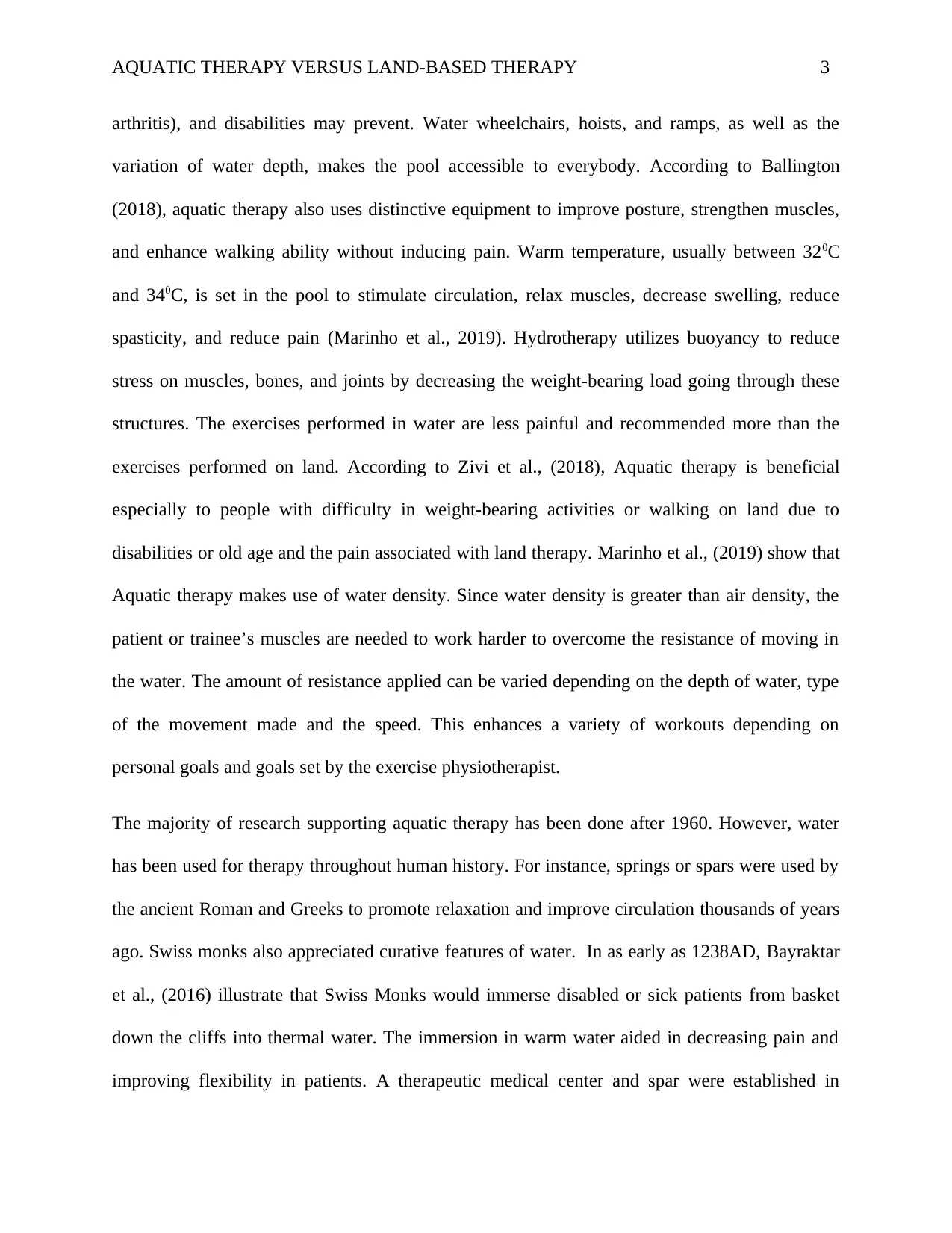
AQUATIC THERAPY VERSUS LAND-BASED THERAPY 3
arthritis), and disabilities may prevent. Water wheelchairs, hoists, and ramps, as well as the
variation of water depth, makes the pool accessible to everybody. According to Ballington
(2018), aquatic therapy also uses distinctive equipment to improve posture, strengthen muscles,
and enhance walking ability without inducing pain. Warm temperature, usually between 320C
and 340C, is set in the pool to stimulate circulation, relax muscles, decrease swelling, reduce
spasticity, and reduce pain (Marinho et al., 2019). Hydrotherapy utilizes buoyancy to reduce
stress on muscles, bones, and joints by decreasing the weight-bearing load going through these
structures. The exercises performed in water are less painful and recommended more than the
exercises performed on land. According to Zivi et al., (2018), Aquatic therapy is beneficial
especially to people with difficulty in weight-bearing activities or walking on land due to
disabilities or old age and the pain associated with land therapy. Marinho et al., (2019) show that
Aquatic therapy makes use of water density. Since water density is greater than air density, the
patient or trainee’s muscles are needed to work harder to overcome the resistance of moving in
the water. The amount of resistance applied can be varied depending on the depth of water, type
of the movement made and the speed. This enhances a variety of workouts depending on
personal goals and goals set by the exercise physiotherapist.
The majority of research supporting aquatic therapy has been done after 1960. However, water
has been used for therapy throughout human history. For instance, springs or spars were used by
the ancient Roman and Greeks to promote relaxation and improve circulation thousands of years
ago. Swiss monks also appreciated curative features of water. In as early as 1238AD, Bayraktar
et al., (2016) illustrate that Swiss Monks would immerse disabled or sick patients from basket
down the cliffs into thermal water. The immersion in warm water aided in decreasing pain and
improving flexibility in patients. A therapeutic medical center and spar were established in
arthritis), and disabilities may prevent. Water wheelchairs, hoists, and ramps, as well as the
variation of water depth, makes the pool accessible to everybody. According to Ballington
(2018), aquatic therapy also uses distinctive equipment to improve posture, strengthen muscles,
and enhance walking ability without inducing pain. Warm temperature, usually between 320C
and 340C, is set in the pool to stimulate circulation, relax muscles, decrease swelling, reduce
spasticity, and reduce pain (Marinho et al., 2019). Hydrotherapy utilizes buoyancy to reduce
stress on muscles, bones, and joints by decreasing the weight-bearing load going through these
structures. The exercises performed in water are less painful and recommended more than the
exercises performed on land. According to Zivi et al., (2018), Aquatic therapy is beneficial
especially to people with difficulty in weight-bearing activities or walking on land due to
disabilities or old age and the pain associated with land therapy. Marinho et al., (2019) show that
Aquatic therapy makes use of water density. Since water density is greater than air density, the
patient or trainee’s muscles are needed to work harder to overcome the resistance of moving in
the water. The amount of resistance applied can be varied depending on the depth of water, type
of the movement made and the speed. This enhances a variety of workouts depending on
personal goals and goals set by the exercise physiotherapist.
The majority of research supporting aquatic therapy has been done after 1960. However, water
has been used for therapy throughout human history. For instance, springs or spars were used by
the ancient Roman and Greeks to promote relaxation and improve circulation thousands of years
ago. Swiss monks also appreciated curative features of water. In as early as 1238AD, Bayraktar
et al., (2016) illustrate that Swiss Monks would immerse disabled or sick patients from basket
down the cliffs into thermal water. The immersion in warm water aided in decreasing pain and
improving flexibility in patients. A therapeutic medical center and spar were established in
⊘ This is a preview!⊘
Do you want full access?
Subscribe today to unlock all pages.

Trusted by 1+ million students worldwide
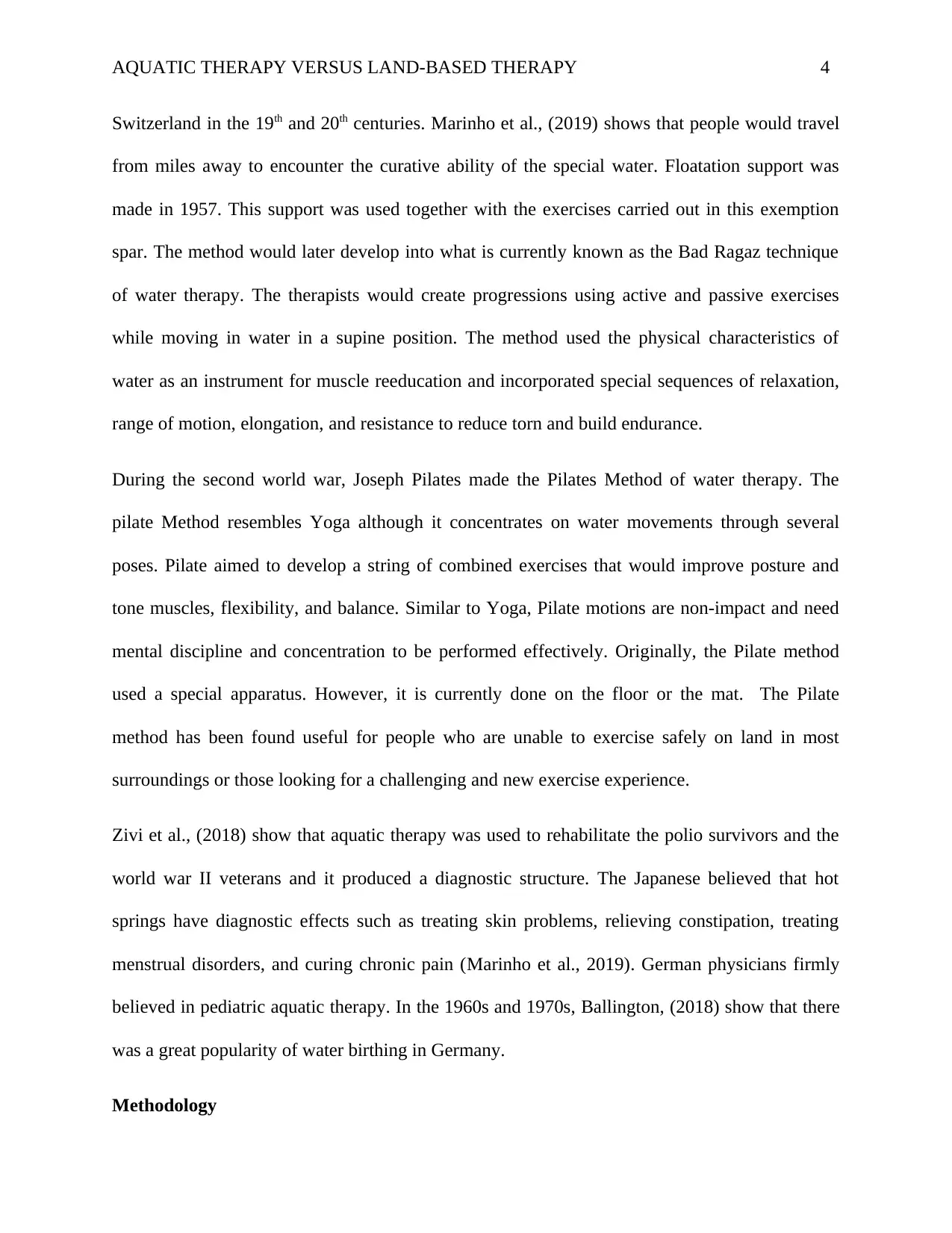
AQUATIC THERAPY VERSUS LAND-BASED THERAPY 4
Switzerland in the 19th and 20th centuries. Marinho et al., (2019) shows that people would travel
from miles away to encounter the curative ability of the special water. Floatation support was
made in 1957. This support was used together with the exercises carried out in this exemption
spar. The method would later develop into what is currently known as the Bad Ragaz technique
of water therapy. The therapists would create progressions using active and passive exercises
while moving in water in a supine position. The method used the physical characteristics of
water as an instrument for muscle reeducation and incorporated special sequences of relaxation,
range of motion, elongation, and resistance to reduce torn and build endurance.
During the second world war, Joseph Pilates made the Pilates Method of water therapy. The
pilate Method resembles Yoga although it concentrates on water movements through several
poses. Pilate aimed to develop a string of combined exercises that would improve posture and
tone muscles, flexibility, and balance. Similar to Yoga, Pilate motions are non-impact and need
mental discipline and concentration to be performed effectively. Originally, the Pilate method
used a special apparatus. However, it is currently done on the floor or the mat. The Pilate
method has been found useful for people who are unable to exercise safely on land in most
surroundings or those looking for a challenging and new exercise experience.
Zivi et al., (2018) show that aquatic therapy was used to rehabilitate the polio survivors and the
world war II veterans and it produced a diagnostic structure. The Japanese believed that hot
springs have diagnostic effects such as treating skin problems, relieving constipation, treating
menstrual disorders, and curing chronic pain (Marinho et al., 2019). German physicians firmly
believed in pediatric aquatic therapy. In the 1960s and 1970s, Ballington, (2018) show that there
was a great popularity of water birthing in Germany.
Methodology
Switzerland in the 19th and 20th centuries. Marinho et al., (2019) shows that people would travel
from miles away to encounter the curative ability of the special water. Floatation support was
made in 1957. This support was used together with the exercises carried out in this exemption
spar. The method would later develop into what is currently known as the Bad Ragaz technique
of water therapy. The therapists would create progressions using active and passive exercises
while moving in water in a supine position. The method used the physical characteristics of
water as an instrument for muscle reeducation and incorporated special sequences of relaxation,
range of motion, elongation, and resistance to reduce torn and build endurance.
During the second world war, Joseph Pilates made the Pilates Method of water therapy. The
pilate Method resembles Yoga although it concentrates on water movements through several
poses. Pilate aimed to develop a string of combined exercises that would improve posture and
tone muscles, flexibility, and balance. Similar to Yoga, Pilate motions are non-impact and need
mental discipline and concentration to be performed effectively. Originally, the Pilate method
used a special apparatus. However, it is currently done on the floor or the mat. The Pilate
method has been found useful for people who are unable to exercise safely on land in most
surroundings or those looking for a challenging and new exercise experience.
Zivi et al., (2018) show that aquatic therapy was used to rehabilitate the polio survivors and the
world war II veterans and it produced a diagnostic structure. The Japanese believed that hot
springs have diagnostic effects such as treating skin problems, relieving constipation, treating
menstrual disorders, and curing chronic pain (Marinho et al., 2019). German physicians firmly
believed in pediatric aquatic therapy. In the 1960s and 1970s, Ballington, (2018) show that there
was a great popularity of water birthing in Germany.
Methodology
Paraphrase This Document
Need a fresh take? Get an instant paraphrase of this document with our AI Paraphraser
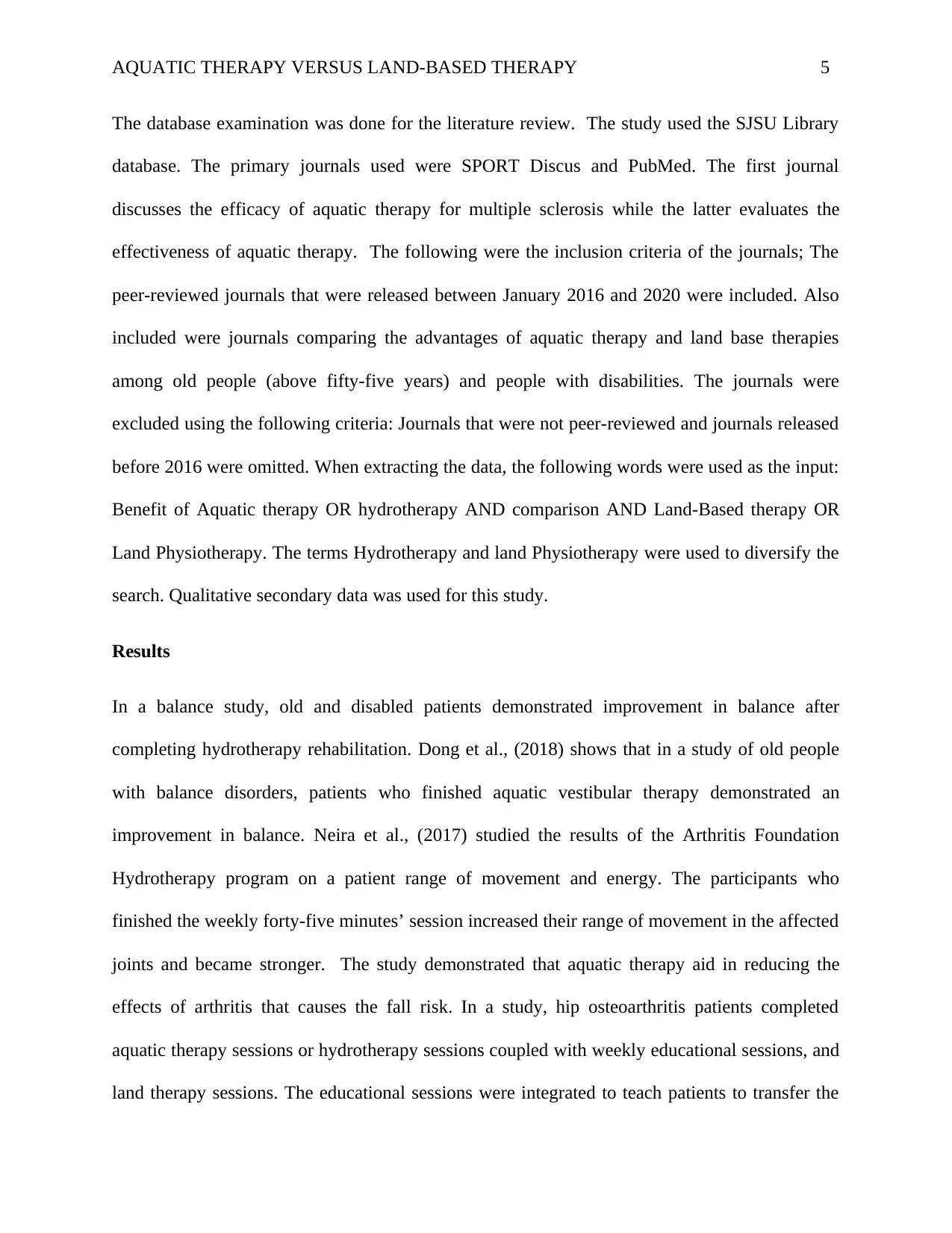
AQUATIC THERAPY VERSUS LAND-BASED THERAPY 5
The database examination was done for the literature review. The study used the SJSU Library
database. The primary journals used were SPORT Discus and PubMed. The first journal
discusses the efficacy of aquatic therapy for multiple sclerosis while the latter evaluates the
effectiveness of aquatic therapy. The following were the inclusion criteria of the journals; The
peer-reviewed journals that were released between January 2016 and 2020 were included. Also
included were journals comparing the advantages of aquatic therapy and land base therapies
among old people (above fifty-five years) and people with disabilities. The journals were
excluded using the following criteria: Journals that were not peer-reviewed and journals released
before 2016 were omitted. When extracting the data, the following words were used as the input:
Benefit of Aquatic therapy OR hydrotherapy AND comparison AND Land-Based therapy OR
Land Physiotherapy. The terms Hydrotherapy and land Physiotherapy were used to diversify the
search. Qualitative secondary data was used for this study.
Results
In a balance study, old and disabled patients demonstrated improvement in balance after
completing hydrotherapy rehabilitation. Dong et al., (2018) shows that in a study of old people
with balance disorders, patients who finished aquatic vestibular therapy demonstrated an
improvement in balance. Neira et al., (2017) studied the results of the Arthritis Foundation
Hydrotherapy program on a patient range of movement and energy. The participants who
finished the weekly forty-five minutes’ session increased their range of movement in the affected
joints and became stronger. The study demonstrated that aquatic therapy aid in reducing the
effects of arthritis that causes the fall risk. In a study, hip osteoarthritis patients completed
aquatic therapy sessions or hydrotherapy sessions coupled with weekly educational sessions, and
land therapy sessions. The educational sessions were integrated to teach patients to transfer the
The database examination was done for the literature review. The study used the SJSU Library
database. The primary journals used were SPORT Discus and PubMed. The first journal
discusses the efficacy of aquatic therapy for multiple sclerosis while the latter evaluates the
effectiveness of aquatic therapy. The following were the inclusion criteria of the journals; The
peer-reviewed journals that were released between January 2016 and 2020 were included. Also
included were journals comparing the advantages of aquatic therapy and land base therapies
among old people (above fifty-five years) and people with disabilities. The journals were
excluded using the following criteria: Journals that were not peer-reviewed and journals released
before 2016 were omitted. When extracting the data, the following words were used as the input:
Benefit of Aquatic therapy OR hydrotherapy AND comparison AND Land-Based therapy OR
Land Physiotherapy. The terms Hydrotherapy and land Physiotherapy were used to diversify the
search. Qualitative secondary data was used for this study.
Results
In a balance study, old and disabled patients demonstrated improvement in balance after
completing hydrotherapy rehabilitation. Dong et al., (2018) shows that in a study of old people
with balance disorders, patients who finished aquatic vestibular therapy demonstrated an
improvement in balance. Neira et al., (2017) studied the results of the Arthritis Foundation
Hydrotherapy program on a patient range of movement and energy. The participants who
finished the weekly forty-five minutes’ session increased their range of movement in the affected
joints and became stronger. The study demonstrated that aquatic therapy aid in reducing the
effects of arthritis that causes the fall risk. In a study, hip osteoarthritis patients completed
aquatic therapy sessions or hydrotherapy sessions coupled with weekly educational sessions, and
land therapy sessions. The educational sessions were integrated to teach patients to transfer the
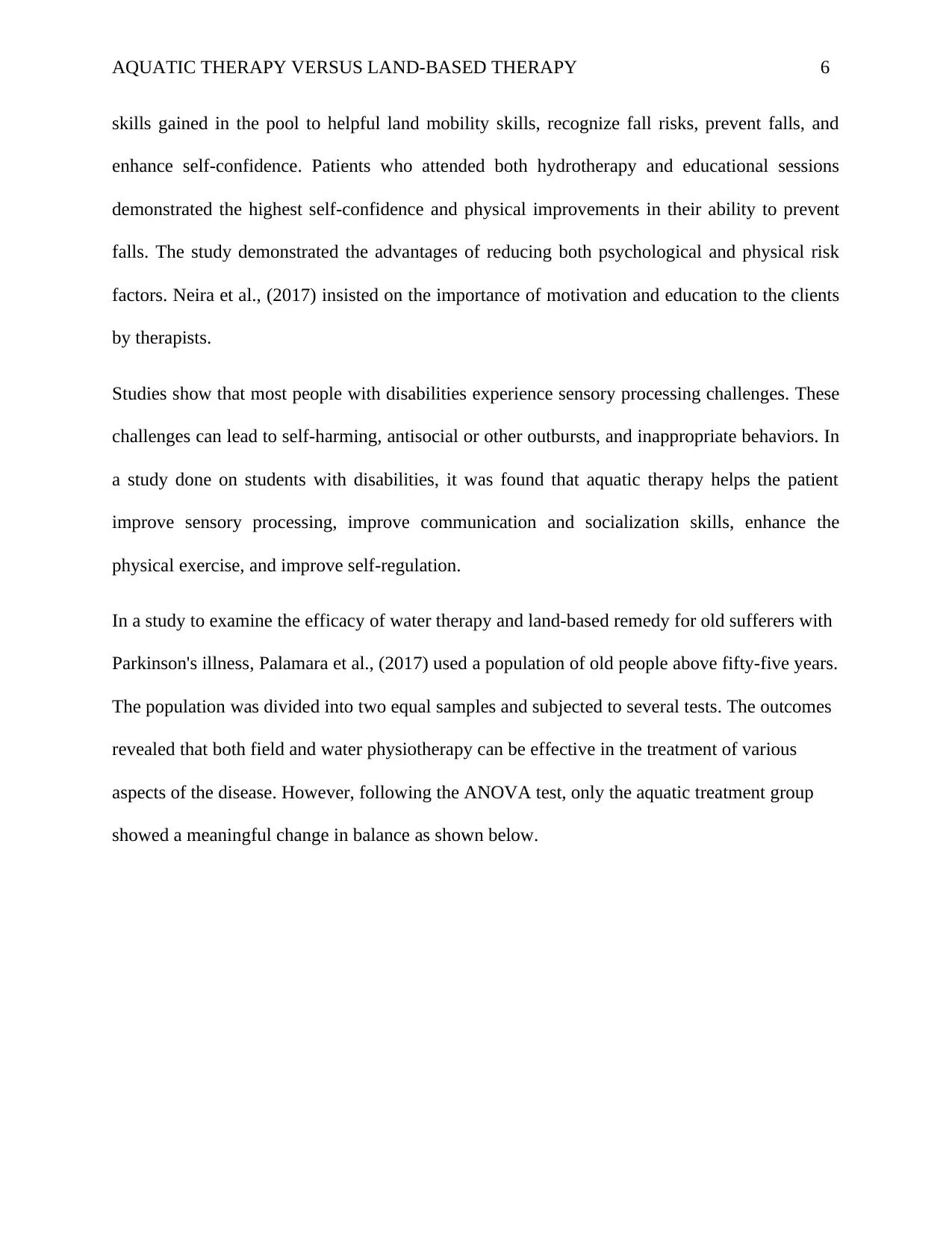
AQUATIC THERAPY VERSUS LAND-BASED THERAPY 6
skills gained in the pool to helpful land mobility skills, recognize fall risks, prevent falls, and
enhance self-confidence. Patients who attended both hydrotherapy and educational sessions
demonstrated the highest self-confidence and physical improvements in their ability to prevent
falls. The study demonstrated the advantages of reducing both psychological and physical risk
factors. Neira et al., (2017) insisted on the importance of motivation and education to the clients
by therapists.
Studies show that most people with disabilities experience sensory processing challenges. These
challenges can lead to self-harming, antisocial or other outbursts, and inappropriate behaviors. In
a study done on students with disabilities, it was found that aquatic therapy helps the patient
improve sensory processing, improve communication and socialization skills, enhance the
physical exercise, and improve self-regulation.
In a study to examine the efficacy of water therapy and land-based remedy for old sufferers with
Parkinson's illness, Palamara et al., (2017) used a population of old people above fifty-five years.
The population was divided into two equal samples and subjected to several tests. The outcomes
revealed that both field and water physiotherapy can be effective in the treatment of various
aspects of the disease. However, following the ANOVA test, only the aquatic treatment group
showed a meaningful change in balance as shown below.
skills gained in the pool to helpful land mobility skills, recognize fall risks, prevent falls, and
enhance self-confidence. Patients who attended both hydrotherapy and educational sessions
demonstrated the highest self-confidence and physical improvements in their ability to prevent
falls. The study demonstrated the advantages of reducing both psychological and physical risk
factors. Neira et al., (2017) insisted on the importance of motivation and education to the clients
by therapists.
Studies show that most people with disabilities experience sensory processing challenges. These
challenges can lead to self-harming, antisocial or other outbursts, and inappropriate behaviors. In
a study done on students with disabilities, it was found that aquatic therapy helps the patient
improve sensory processing, improve communication and socialization skills, enhance the
physical exercise, and improve self-regulation.
In a study to examine the efficacy of water therapy and land-based remedy for old sufferers with
Parkinson's illness, Palamara et al., (2017) used a population of old people above fifty-five years.
The population was divided into two equal samples and subjected to several tests. The outcomes
revealed that both field and water physiotherapy can be effective in the treatment of various
aspects of the disease. However, following the ANOVA test, only the aquatic treatment group
showed a meaningful change in balance as shown below.
⊘ This is a preview!⊘
Do you want full access?
Subscribe today to unlock all pages.

Trusted by 1+ million students worldwide
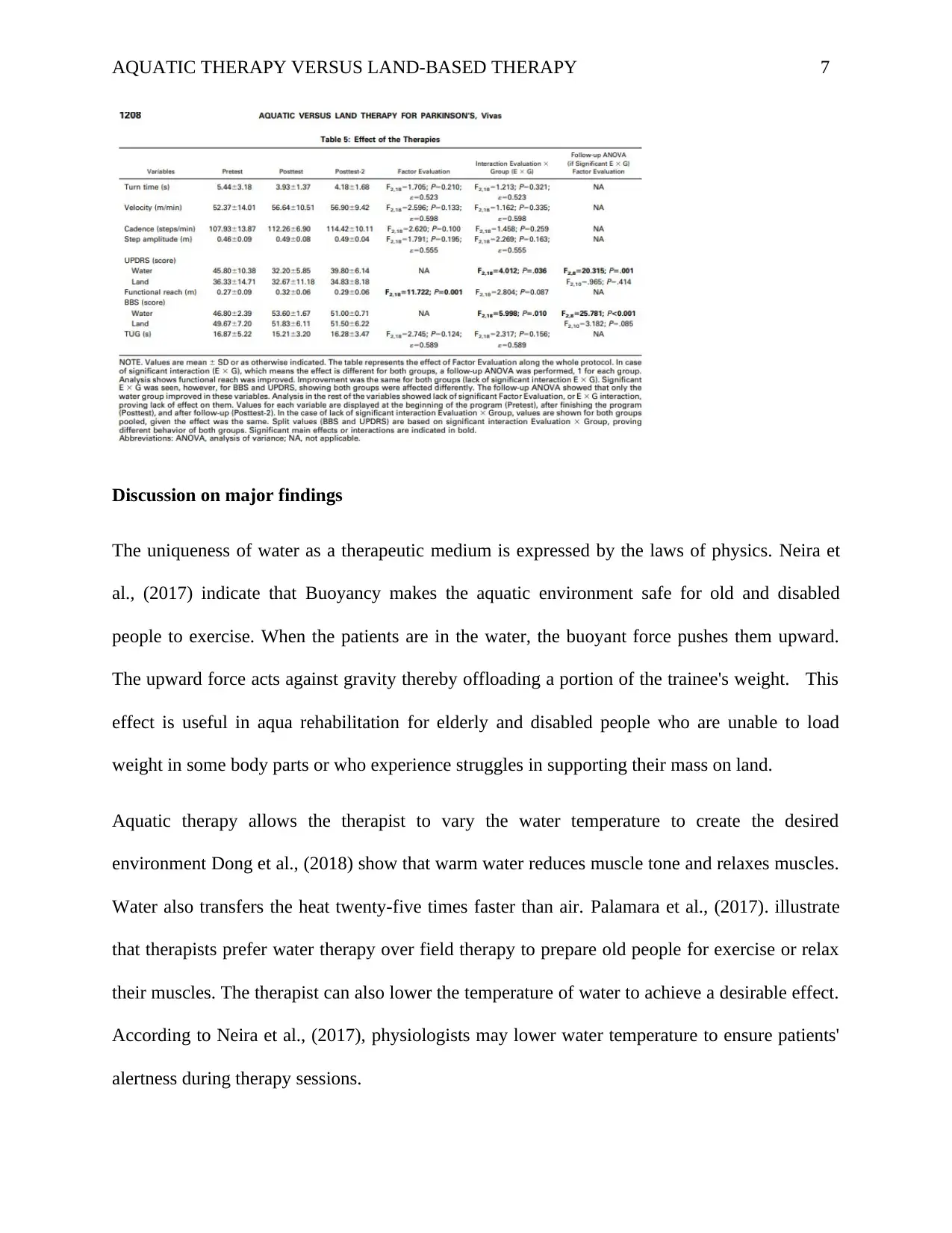
AQUATIC THERAPY VERSUS LAND-BASED THERAPY 7
Discussion on major findings
The uniqueness of water as a therapeutic medium is expressed by the laws of physics. Neira et
al., (2017) indicate that Buoyancy makes the aquatic environment safe for old and disabled
people to exercise. When the patients are in the water, the buoyant force pushes them upward.
The upward force acts against gravity thereby offloading a portion of the trainee's weight. This
effect is useful in aqua rehabilitation for elderly and disabled people who are unable to load
weight in some body parts or who experience struggles in supporting their mass on land.
Aquatic therapy allows the therapist to vary the water temperature to create the desired
environment Dong et al., (2018) show that warm water reduces muscle tone and relaxes muscles.
Water also transfers the heat twenty-five times faster than air. Palamara et al., (2017). illustrate
that therapists prefer water therapy over field therapy to prepare old people for exercise or relax
their muscles. The therapist can also lower the temperature of water to achieve a desirable effect.
According to Neira et al., (2017), physiologists may lower water temperature to ensure patients'
alertness during therapy sessions.
Discussion on major findings
The uniqueness of water as a therapeutic medium is expressed by the laws of physics. Neira et
al., (2017) indicate that Buoyancy makes the aquatic environment safe for old and disabled
people to exercise. When the patients are in the water, the buoyant force pushes them upward.
The upward force acts against gravity thereby offloading a portion of the trainee's weight. This
effect is useful in aqua rehabilitation for elderly and disabled people who are unable to load
weight in some body parts or who experience struggles in supporting their mass on land.
Aquatic therapy allows the therapist to vary the water temperature to create the desired
environment Dong et al., (2018) show that warm water reduces muscle tone and relaxes muscles.
Water also transfers the heat twenty-five times faster than air. Palamara et al., (2017). illustrate
that therapists prefer water therapy over field therapy to prepare old people for exercise or relax
their muscles. The therapist can also lower the temperature of water to achieve a desirable effect.
According to Neira et al., (2017), physiologists may lower water temperature to ensure patients'
alertness during therapy sessions.
Paraphrase This Document
Need a fresh take? Get an instant paraphrase of this document with our AI Paraphraser
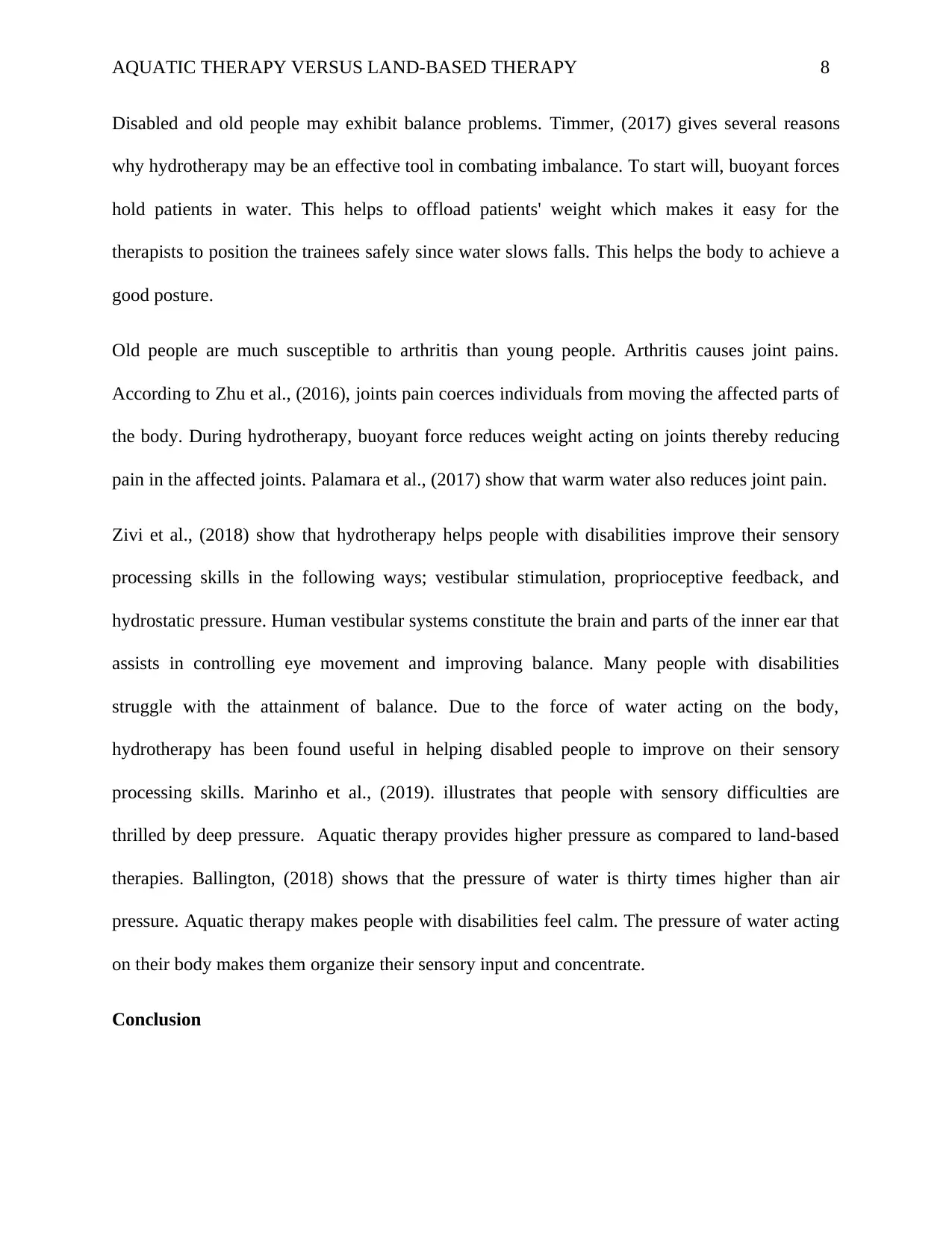
AQUATIC THERAPY VERSUS LAND-BASED THERAPY 8
Disabled and old people may exhibit balance problems. Timmer, (2017) gives several reasons
why hydrotherapy may be an effective tool in combating imbalance. To start will, buoyant forces
hold patients in water. This helps to offload patients' weight which makes it easy for the
therapists to position the trainees safely since water slows falls. This helps the body to achieve a
good posture.
Old people are much susceptible to arthritis than young people. Arthritis causes joint pains.
According to Zhu et al., (2016), joints pain coerces individuals from moving the affected parts of
the body. During hydrotherapy, buoyant force reduces weight acting on joints thereby reducing
pain in the affected joints. Palamara et al., (2017) show that warm water also reduces joint pain.
Zivi et al., (2018) show that hydrotherapy helps people with disabilities improve their sensory
processing skills in the following ways; vestibular stimulation, proprioceptive feedback, and
hydrostatic pressure. Human vestibular systems constitute the brain and parts of the inner ear that
assists in controlling eye movement and improving balance. Many people with disabilities
struggle with the attainment of balance. Due to the force of water acting on the body,
hydrotherapy has been found useful in helping disabled people to improve on their sensory
processing skills. Marinho et al., (2019). illustrates that people with sensory difficulties are
thrilled by deep pressure. Aquatic therapy provides higher pressure as compared to land-based
therapies. Ballington, (2018) shows that the pressure of water is thirty times higher than air
pressure. Aquatic therapy makes people with disabilities feel calm. The pressure of water acting
on their body makes them organize their sensory input and concentrate.
Conclusion
Disabled and old people may exhibit balance problems. Timmer, (2017) gives several reasons
why hydrotherapy may be an effective tool in combating imbalance. To start will, buoyant forces
hold patients in water. This helps to offload patients' weight which makes it easy for the
therapists to position the trainees safely since water slows falls. This helps the body to achieve a
good posture.
Old people are much susceptible to arthritis than young people. Arthritis causes joint pains.
According to Zhu et al., (2016), joints pain coerces individuals from moving the affected parts of
the body. During hydrotherapy, buoyant force reduces weight acting on joints thereby reducing
pain in the affected joints. Palamara et al., (2017) show that warm water also reduces joint pain.
Zivi et al., (2018) show that hydrotherapy helps people with disabilities improve their sensory
processing skills in the following ways; vestibular stimulation, proprioceptive feedback, and
hydrostatic pressure. Human vestibular systems constitute the brain and parts of the inner ear that
assists in controlling eye movement and improving balance. Many people with disabilities
struggle with the attainment of balance. Due to the force of water acting on the body,
hydrotherapy has been found useful in helping disabled people to improve on their sensory
processing skills. Marinho et al., (2019). illustrates that people with sensory difficulties are
thrilled by deep pressure. Aquatic therapy provides higher pressure as compared to land-based
therapies. Ballington, (2018) shows that the pressure of water is thirty times higher than air
pressure. Aquatic therapy makes people with disabilities feel calm. The pressure of water acting
on their body makes them organize their sensory input and concentrate.
Conclusion
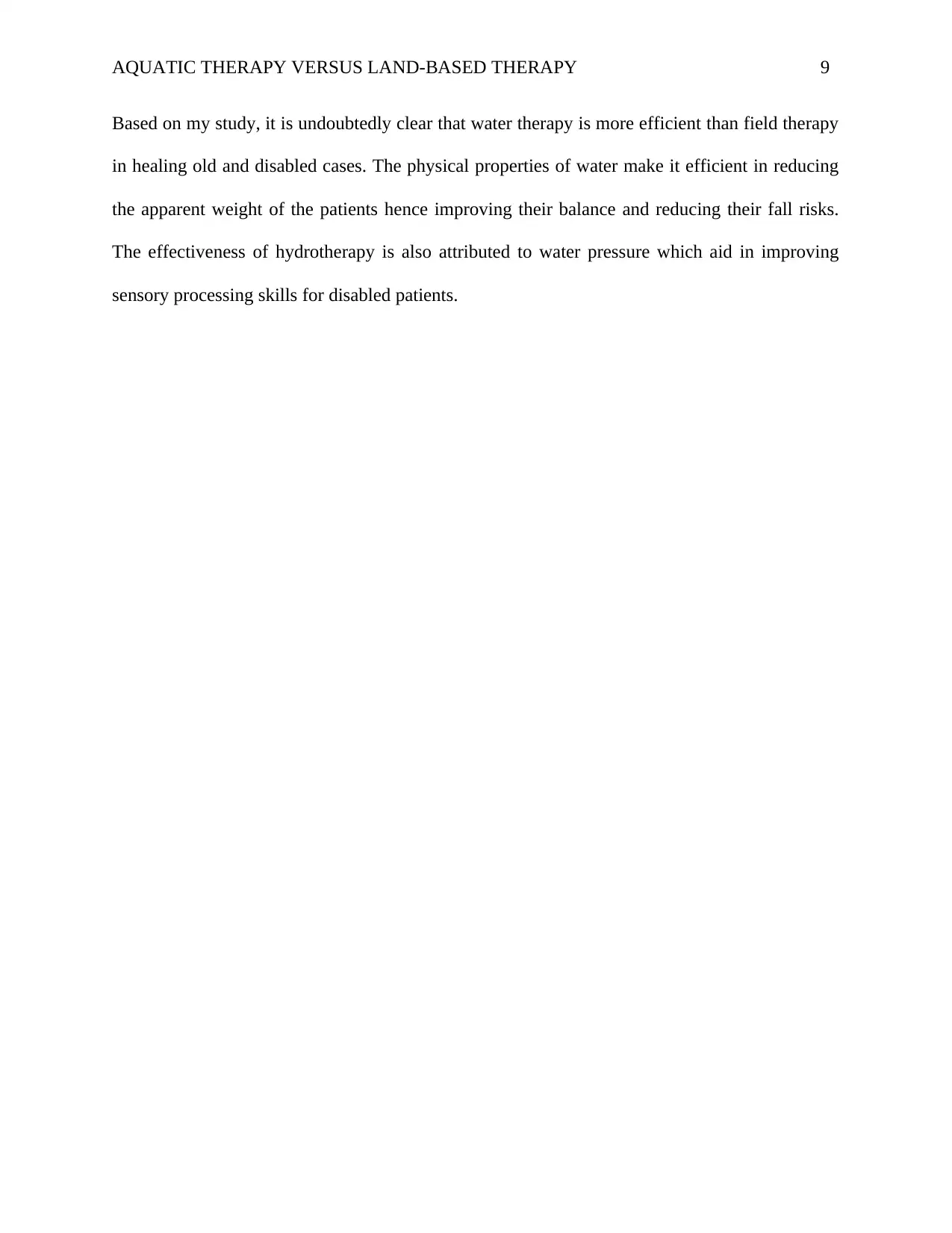
AQUATIC THERAPY VERSUS LAND-BASED THERAPY 9
Based on my study, it is undoubtedly clear that water therapy is more efficient than field therapy
in healing old and disabled cases. The physical properties of water make it efficient in reducing
the apparent weight of the patients hence improving their balance and reducing their fall risks.
The effectiveness of hydrotherapy is also attributed to water pressure which aid in improving
sensory processing skills for disabled patients.
Based on my study, it is undoubtedly clear that water therapy is more efficient than field therapy
in healing old and disabled cases. The physical properties of water make it efficient in reducing
the apparent weight of the patients hence improving their balance and reducing their fall risks.
The effectiveness of hydrotherapy is also attributed to water pressure which aid in improving
sensory processing skills for disabled patients.
⊘ This is a preview!⊘
Do you want full access?
Subscribe today to unlock all pages.

Trusted by 1+ million students worldwide
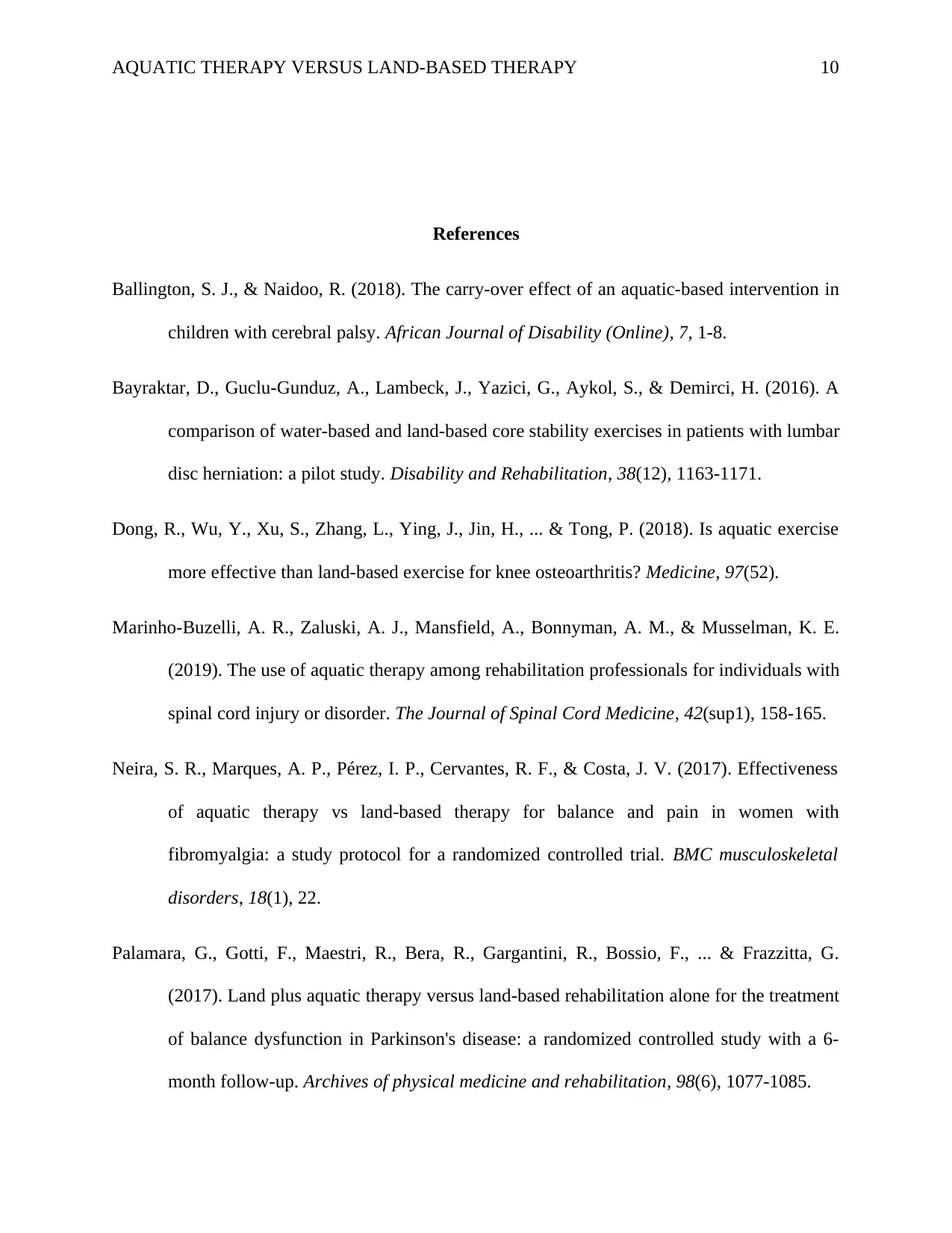
AQUATIC THERAPY VERSUS LAND-BASED THERAPY 10
References
Ballington, S. J., & Naidoo, R. (2018). The carry-over effect of an aquatic-based intervention in
children with cerebral palsy. African Journal of Disability (Online), 7, 1-8.
Bayraktar, D., Guclu-Gunduz, A., Lambeck, J., Yazici, G., Aykol, S., & Demirci, H. (2016). A
comparison of water-based and land-based core stability exercises in patients with lumbar
disc herniation: a pilot study. Disability and Rehabilitation, 38(12), 1163-1171.
Dong, R., Wu, Y., Xu, S., Zhang, L., Ying, J., Jin, H., ... & Tong, P. (2018). Is aquatic exercise
more effective than land-based exercise for knee osteoarthritis? Medicine, 97(52).
Marinho-Buzelli, A. R., Zaluski, A. J., Mansfield, A., Bonnyman, A. M., & Musselman, K. E.
(2019). The use of aquatic therapy among rehabilitation professionals for individuals with
spinal cord injury or disorder. The Journal of Spinal Cord Medicine, 42(sup1), 158-165.
Neira, S. R., Marques, A. P., Pérez, I. P., Cervantes, R. F., & Costa, J. V. (2017). Effectiveness
of aquatic therapy vs land-based therapy for balance and pain in women with
fibromyalgia: a study protocol for a randomized controlled trial. BMC musculoskeletal
disorders, 18(1), 22.
Palamara, G., Gotti, F., Maestri, R., Bera, R., Gargantini, R., Bossio, F., ... & Frazzitta, G.
(2017). Land plus aquatic therapy versus land-based rehabilitation alone for the treatment
of balance dysfunction in Parkinson's disease: a randomized controlled study with a 6-
month follow-up. Archives of physical medicine and rehabilitation, 98(6), 1077-1085.
References
Ballington, S. J., & Naidoo, R. (2018). The carry-over effect of an aquatic-based intervention in
children with cerebral palsy. African Journal of Disability (Online), 7, 1-8.
Bayraktar, D., Guclu-Gunduz, A., Lambeck, J., Yazici, G., Aykol, S., & Demirci, H. (2016). A
comparison of water-based and land-based core stability exercises in patients with lumbar
disc herniation: a pilot study. Disability and Rehabilitation, 38(12), 1163-1171.
Dong, R., Wu, Y., Xu, S., Zhang, L., Ying, J., Jin, H., ... & Tong, P. (2018). Is aquatic exercise
more effective than land-based exercise for knee osteoarthritis? Medicine, 97(52).
Marinho-Buzelli, A. R., Zaluski, A. J., Mansfield, A., Bonnyman, A. M., & Musselman, K. E.
(2019). The use of aquatic therapy among rehabilitation professionals for individuals with
spinal cord injury or disorder. The Journal of Spinal Cord Medicine, 42(sup1), 158-165.
Neira, S. R., Marques, A. P., Pérez, I. P., Cervantes, R. F., & Costa, J. V. (2017). Effectiveness
of aquatic therapy vs land-based therapy for balance and pain in women with
fibromyalgia: a study protocol for a randomized controlled trial. BMC musculoskeletal
disorders, 18(1), 22.
Palamara, G., Gotti, F., Maestri, R., Bera, R., Gargantini, R., Bossio, F., ... & Frazzitta, G.
(2017). Land plus aquatic therapy versus land-based rehabilitation alone for the treatment
of balance dysfunction in Parkinson's disease: a randomized controlled study with a 6-
month follow-up. Archives of physical medicine and rehabilitation, 98(6), 1077-1085.
Paraphrase This Document
Need a fresh take? Get an instant paraphrase of this document with our AI Paraphraser
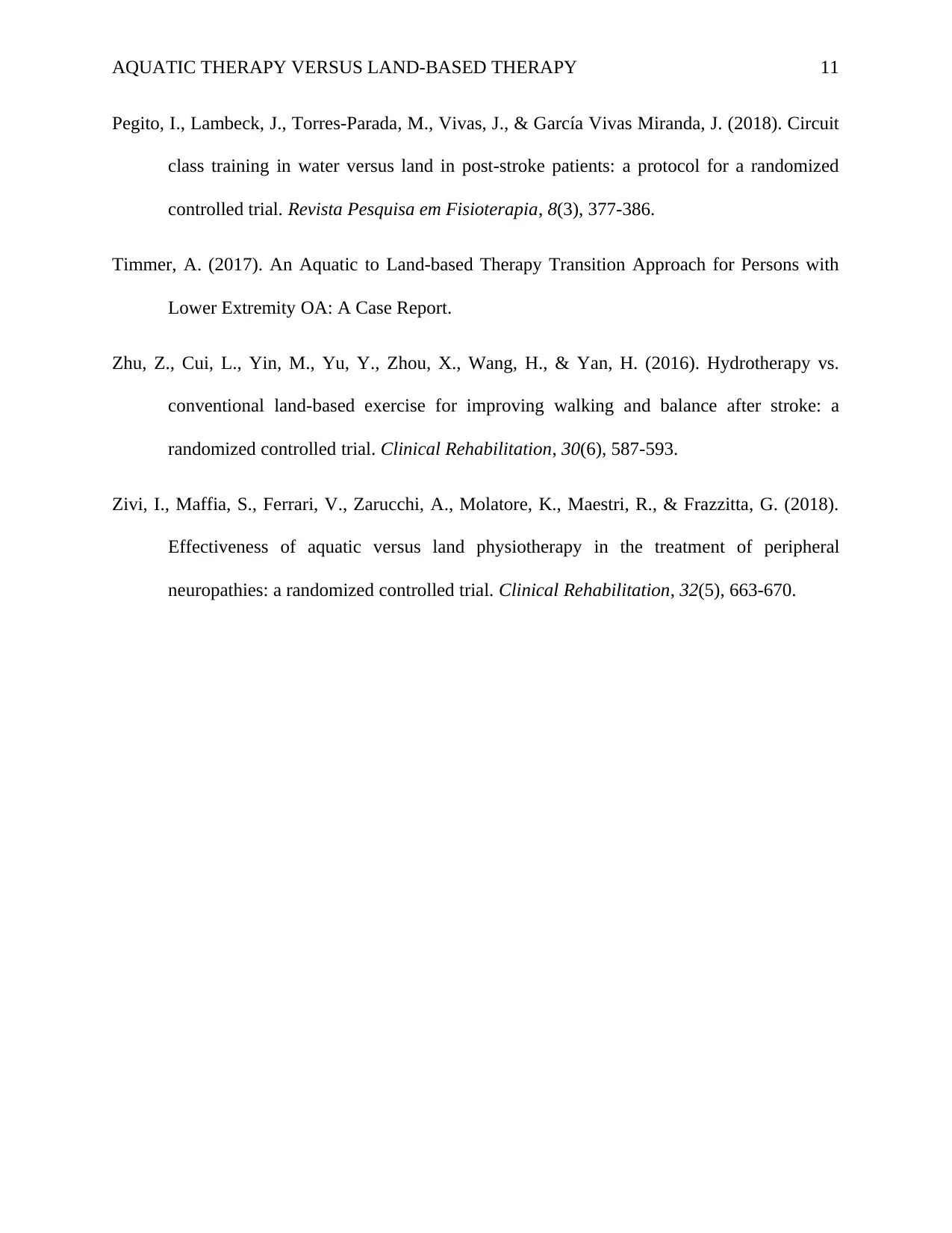
AQUATIC THERAPY VERSUS LAND-BASED THERAPY 11
Pegito, I., Lambeck, J., Torres-Parada, M., Vivas, J., & García Vivas Miranda, J. (2018). Circuit
class training in water versus land in post-stroke patients: a protocol for a randomized
controlled trial. Revista Pesquisa em Fisioterapia, 8(3), 377-386.
Timmer, A. (2017). An Aquatic to Land-based Therapy Transition Approach for Persons with
Lower Extremity OA: A Case Report.
Zhu, Z., Cui, L., Yin, M., Yu, Y., Zhou, X., Wang, H., & Yan, H. (2016). Hydrotherapy vs.
conventional land-based exercise for improving walking and balance after stroke: a
randomized controlled trial. Clinical Rehabilitation, 30(6), 587-593.
Zivi, I., Maffia, S., Ferrari, V., Zarucchi, A., Molatore, K., Maestri, R., & Frazzitta, G. (2018).
Effectiveness of aquatic versus land physiotherapy in the treatment of peripheral
neuropathies: a randomized controlled trial. Clinical Rehabilitation, 32(5), 663-670.
Pegito, I., Lambeck, J., Torres-Parada, M., Vivas, J., & García Vivas Miranda, J. (2018). Circuit
class training in water versus land in post-stroke patients: a protocol for a randomized
controlled trial. Revista Pesquisa em Fisioterapia, 8(3), 377-386.
Timmer, A. (2017). An Aquatic to Land-based Therapy Transition Approach for Persons with
Lower Extremity OA: A Case Report.
Zhu, Z., Cui, L., Yin, M., Yu, Y., Zhou, X., Wang, H., & Yan, H. (2016). Hydrotherapy vs.
conventional land-based exercise for improving walking and balance after stroke: a
randomized controlled trial. Clinical Rehabilitation, 30(6), 587-593.
Zivi, I., Maffia, S., Ferrari, V., Zarucchi, A., Molatore, K., Maestri, R., & Frazzitta, G. (2018).
Effectiveness of aquatic versus land physiotherapy in the treatment of peripheral
neuropathies: a randomized controlled trial. Clinical Rehabilitation, 32(5), 663-670.
1 out of 11
Your All-in-One AI-Powered Toolkit for Academic Success.
+13062052269
info@desklib.com
Available 24*7 on WhatsApp / Email
![[object Object]](/_next/static/media/star-bottom.7253800d.svg)
Unlock your academic potential
Copyright © 2020–2025 A2Z Services. All Rights Reserved. Developed and managed by ZUCOL.